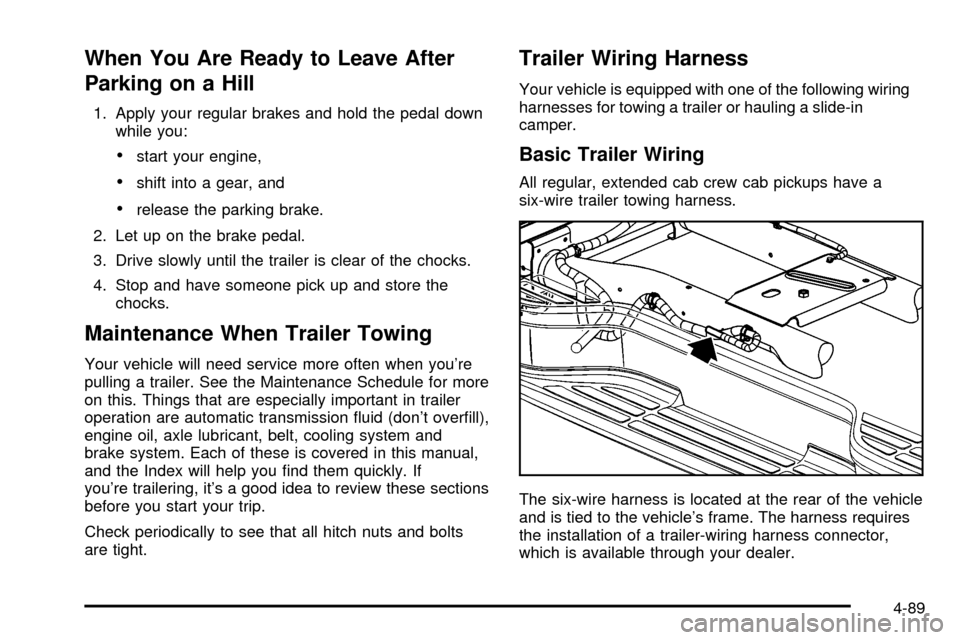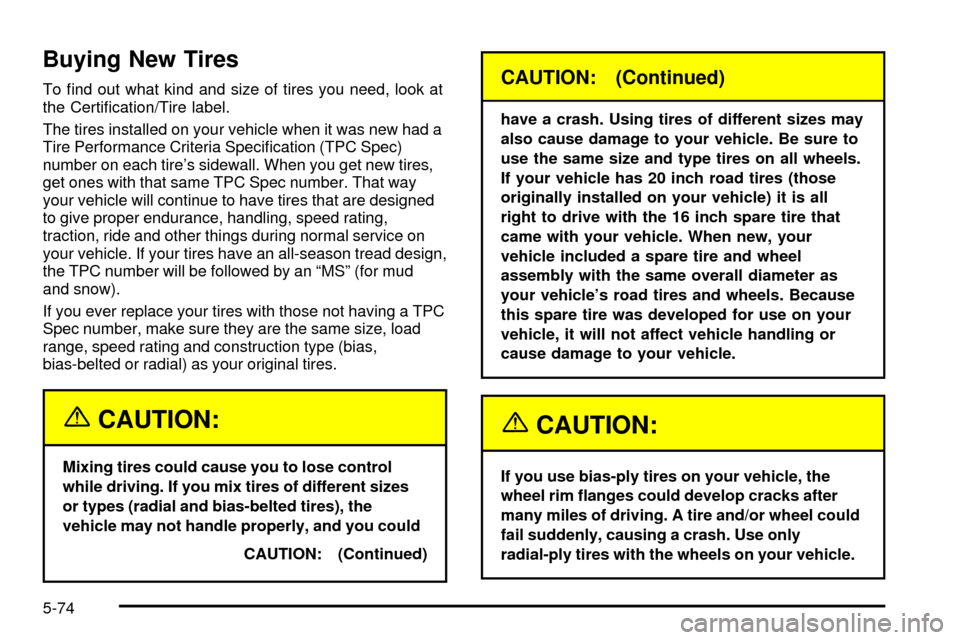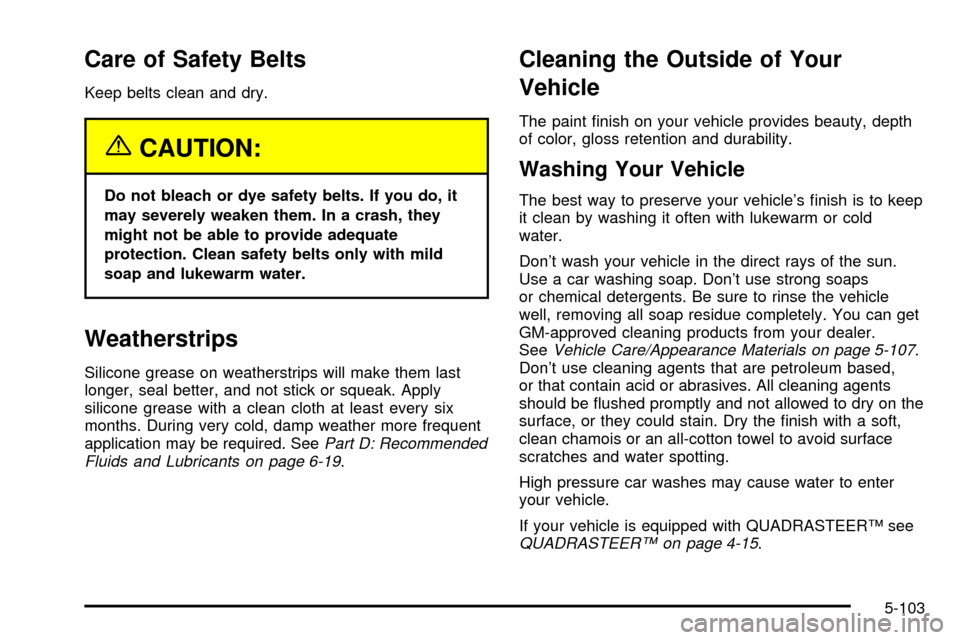2003 CHEVROLET SILVERADO belt
[x] Cancel search: beltPage 371 of 556

When You Are Ready to Leave After
Parking on a Hill
1. Apply your regular brakes and hold the pedal down
while you:
·start your engine,
·shift into a gear, and
·release the parking brake.
2. Let up on the brake pedal.
3. Drive slowly until the trailer is clear of the chocks.
4. Stop and have someone pick up and store the
chocks.
Maintenance When Trailer Towing
Your vehicle will need service more often when you're
pulling a trailer. See the Maintenance Schedule for more
on this. Things that are especially important in trailer
operation are automatic transmission ¯uid (don't over®ll),
engine oil, axle lubricant, belt, cooling system and
brake system. Each of these is covered in this manual,
and the Index will help you ®nd them quickly. If
you're trailering, it's a good idea to review these sections
before you start your trip.
Check periodically to see that all hitch nuts and bolts
are tight.
Trailer Wiring Harness
Your vehicle is equipped with one of the following wiring
harnesses for towing a trailer or hauling a slide-in
camper.
Basic Trailer Wiring
All regular, extended cab crew cab pickups have a
six-wire trailer towing harness.
The six-wire harness is located at the rear of the vehicle
and is tied to the vehicle's frame. The harness requires
the installation of a trailer-wiring harness connector,
which is available through your dealer.
4-89
Page 382 of 556

Bulb Replacement..........................................5-59
Halogen Bulbs..............................................5-59
Headlamps..................................................5-59
Front Turn Signal, Sidemarker and Daytime
Running Lamps.........................................5-61
Roof Marker Lamps......................................5-62
Center High-Mounted Stoplamp (CHMSL) and
Cargo Lamp.............................................5-63
Pickup Box Identi®cation and Fender Marker
Lamps.....................................................5-65
Taillamps.....................................................5-65
Replacement Bulbs.......................................5-67
Windshield Wiper Blade Replacement..............5-68
Tires..............................................................5-69
In¯ation -- Tire Pressure................................5-69
Dual Tire Operation.......................................5-70
Tire Inspection and Rotation...........................5-71
When It Is Time for New Tires.......................5-73
Buying New Tires.........................................5-74
Uniform Tire Quality Grading..........................5-75
Wheel Alignment and Tire Balance..................5-76
Wheel Replacement......................................5-76
Tire Chains..................................................5-78
If a Tire Goes Flat........................................5-79
Changing a Flat Tire.....................................5-80Appearance Care..........................................5-100
Cleaning the Inside of Your Vehicle...............5-100
Care of Safety Belts....................................5-103
Weatherstrips.............................................5-103
Cleaning the Outside of Your Vehicle.............5-103
Sheet Metal Damage...................................5-105
Finish Damage...........................................5-106
Underbody Maintenance...............................5-106
Chemical Paint Spotting...............................5-106
Vehicle Care/Appearance Materials................5-107
Vehicle Identi®cation.....................................5-108
Vehicle Identi®cation Number (VIN)................5-108
Service Parts Identi®cation Label...................5-109
Electrical System..........................................5-109
Add-On Electrical Equipment.........................5-109
Windshield Wiper Fuses...............................5-109
Power Windows and Other Power Options......5-109
Fuses and Circuit Breakers..........................5-110
Capacities and Speci®cations........................5-118
Capacities and Speci®cations........................5-118
Normal Maintenance Replacement Parts.........5-121
Section 5 Service and Appearance Care
5-2
Page 454 of 556

Buying New Tires
To ®nd out what kind and size of tires you need, look at
the Certi®cation/Tire label.
The tires installed on your vehicle when it was new had a
Tire Performance Criteria Speci®cation (TPC Spec)
number on each tire's sidewall. When you get new tires,
get ones with that same TPC Spec number. That way
your vehicle will continue to have tires that are designed
to give proper endurance, handling, speed rating,
traction, ride and other things during normal service on
your vehicle. If your tires have an all-season tread design,
the TPC number will be followed by an ªMSº (for mud
and snow).
If you ever replace your tires with those not having a TPC
Spec number, make sure they are the same size, load
range, speed rating and construction type (bias,
bias-belted or radial) as your original tires.
{CAUTION:
Mixing tires could cause you to lose control
while driving. If you mix tires of different sizes
or types (radial and bias-belted tires), the
vehicle may not handle properly, and you could
CAUTION: (Continued)
CAUTION: (Continued)
have a crash. Using tires of different sizes may
also cause damage to your vehicle. Be sure to
use the same size and type tires on all wheels.
If your vehicle has 20 inch road tires (those
originally installed on your vehicle) it is all
right to drive with the 16 inch spare tire that
came with your vehicle. When new, your
vehicle included a spare tire and wheel
assembly with the same overall diameter as
your vehicle's road tires and wheels. Because
this spare tire was developed for use on your
vehicle, it will not affect vehicle handling or
cause damage to your vehicle.
{CAUTION:
If you use bias-ply tires on your vehicle, the
wheel rim ¯anges could develop cracks after
many miles of driving. A tire and/or wheel could
fail suddenly, causing a crash. Use only
radial-ply tires with the wheels on your vehicle.
5-74
Page 483 of 556

Care of Safety Belts
Keep belts clean and dry.
{CAUTION:
Do not bleach or dye safety belts. If you do, it
may severely weaken them. In a crash, they
might not be able to provide adequate
protection. Clean safety belts only with mild
soap and lukewarm water.
Weatherstrips
Silicone grease on weatherstrips will make them last
longer, seal better, and not stick or squeak. Apply
silicone grease with a clean cloth at least every six
months. During very cold, damp weather more frequent
application may be required. See
Part D: Recommended
Fluids and Lubricants on page 6-19.
Cleaning the Outside of Your
Vehicle
The paint ®nish on your vehicle provides beauty, depth
of color, gloss retention and durability.
Washing Your Vehicle
The best way to preserve your vehicle's ®nish is to keep
it clean by washing it often with lukewarm or cold
water.
Don't wash your vehicle in the direct rays of the sun.
Use a car washing soap. Don't use strong soaps
or chemical detergents. Be sure to rinse the vehicle
well, removing all soap residue completely. You can get
GM-approved cleaning products from your dealer.
See
Vehicle Care/Appearance Materials on page 5-107.
Don't use cleaning agents that are petroleum based,
or that contain acid or abrasives. All cleaning agents
should be ¯ushed promptly and not allowed to dry on the
surface, or they could stain. Dry the ®nish with a soft,
clean chamois or an all-cotton towel to avoid surface
scratches and water spotting.
High pressure car washes may cause water to enter
your vehicle.
If your vehicle is equipped with QUADRASTEERŸ see
QUADRASTEERŸ on page 4-15.
5-103
Page 513 of 556

100,000 Miles (166 000 km)
qInspect spark plug wires.An Emission Control
Service.
qReplace spark plugs.An Emission Control Service.
qChange automatic transmission ¯uid and ®lter if
the vehicle's GVWR is over 8600 lbs, if the
vehicle has an Allison transmission or if the vehicle is
mainly driven under one or more of these conditions:
þ In heavy city traffic where the outside
temperature regularly reaches 90ÉF (32ÉC) or
higher.
þ In hilly or mountainous terrain.
þ When doing frequent trailer towing.
þ Uses such as found in taxi, police or delivery
service.
qIf you haven't used your vehicle under severe service
conditions listed previously and, therefore, haven't
changed your automatic transmission ¯uid, change
both the ¯uid and ®lterqAutomatic Transfer Case Only: Change transfer case
¯uid
qExcept 8.1L V8 Engine: Inspect Positive Crankcase
Ventilation (PCV) valve.
An Emission Control
Service.
150,000 Miles (240 000 km)
qDrain, ¯ush and re®ll cooling system (or every
60 months since last service, whichever occurs ®rst).
See
Engine Coolant on page 5-30for what to use.
Inspect hoses. Clean radiator, condenser, pressure
cap and neck. Pressure test the cooling system
and pressure cap.
An Emission Control Service.
qChange ®ve-speed manual transmission ¯uid (with
4300 V6 or 4800 V8 engines only).
qInspect engine accessory drive belt.
An Emission
Control Service.
200,000 Miles (332 000 km)
q6000 V8 Engine Only: Change ®ve-speed manual
transmission ¯uid.
6-11
Page 515 of 556

At Least Twice a Year
Restraint System Check
Make sure the safety belt reminder light and all your
belts, buckles, latch plates, retractors and anchorages
are working properly. Look for any other loose or
damaged safety belt system parts. If you see anything
that might keep a safety belt system from doing its
job, have it repaired. Have any torn or frayed safety belts
replaced.
Also look for any opened or broken air bag coverings,
and have them repaired or replaced. (The air bag
system does not need regular maintenance.)
Wiper Blade Check
Inspect wiper blades for wear or cracking. Replace
blade inserts that appear worn or damaged or that
streak or miss areas of the windshield. Also see
Cleaning the Outside of Your Vehicle on page 5-103.
Spare Tire Check
At least twice a year, after the monthly in¯ation check of
the spare tire determines that the spare is in¯ated to
the correct tire in¯ation pressure, make sure that
the spare tire is stored securely. Push, pull, and then try
to rotate or turn the tire. If it moves, use the wheel
wrench/ratchet to tighten the cable. See
Changing a Flat
Tire on page 5-80.
Weatherstrip Lubrication
Silicone grease on weatherstrips will make them last
longer, seal better, and not stick or squeak. Apply
silicone grease with a clean cloth. During very cold,
damp weather more frequent application may be
required. See
Part D: Recommended Fluids and
Lubricants on page 6-19.
Manual Transmission Check
Check the transmission ¯uid level; add if needed. SeeManual Transmission Fluid on page 5-28. Check
for leaks. A ¯uid leak is the only reason for ¯uid loss.
Have the system inspected and repaired if needed.
Automatic Transmission Check
Check the transmission ¯uid level; add if needed. SeeAutomatic Transmission Fluid (Except Allison
Transmissionž) on page 5-23orAutomatic Transmission
Fluid (Allison Transmissionž) on page 5-26. A ¯uid
loss may indicate a problem. Check the system
and repair if needed.
6-13
Page 537 of 556

A
Accessory Power Outlets.................................3-19
Adding a Snow Plow or Similar Equipment.........4-61
Adding Washer Fluid.......................................5-43
Additional Program Information........................... 7-8
Additives, Fuel................................................. 5-5
Add-On Electrical Equipment...........................5-109
Add-On Equipment..........................................4-60
Adjusting the Speakers
(Balance/Fade)..................3-74, 3-78, 3-88, 3-101
After Off-Road Driving.....................................4-37
Air Bag Systems.............................................1-64
Adding Equipment to Your Air Bag-Equipped
Vehicle...................................................1-80
Air Bag Off Switch.......................................1-71
How Does an Air Bag Restrain?....................1-69
Passenger Sensing System...........................1-76
Servicing Your Air Bag-Equipped Vehicle.........1-80
What Makes an Air Bag In¯ate?....................1-69
What Will You See After an Air Bag In¯ates?......1-70
When Should an Air Bag In¯ate?...................1-68
Where Are the Air Bags?..............................1-66
Air Bag .........................................................3-37
Off Light.....................................................3-37
Passenger Status Indicator...........................3-40
Readiness Light..........................................3-36
Air Cleaner/Filter, Engine.................................5-21
Air Conditioning..............................................3-30
All-Wheel Drive (AWD) System.........................2-44All-Wheel Drive...............................................5-54
AM-FM Radio.................................................3-72
AM .............................................................3-123
Antenna, Fixed Mast......................................3-125
Antenna, XMŸ Satellite Radio Antenna
System.....................................................3-125
Anti-Lock Brake, System Warning Light..............3-45
Anti-lock Brake System..................................... 4-6
Appearance Care..........................................5-100
Care of Safety Belts...................................5-103
Chemical Paint Spotting..............................5-106
Cleaning the Inside of Your Vehicle..............5-100
Cleaning the Outside of Your Vehicle............5-103
Finish Damage..........................................5-106
Sheet Metal Damage..................................5-105
Underbody Maintenance.............................5-106
Vehicle Care/Appearance Materials...............5-107
Weatherstrips............................................5-103
Approaching a Hill..........................................4-28
Ashtrays........................................................3-20
Audio Output................................................3-117
Audio System(s).............................................3-71
AM-FM Radio.............................................3-72
Audio Steering Wheel Controls....................3-122
Care of Your Cassette Tape Player...............3-123
Care of Your CD and DVD Player................3-124
Care of Your CDs and DVDs.......................3-124
Chime Level Adjustment.............................3-125
Fixed Mast Antenna...................................3-125
Radio with Cassette and CD.........................3-85
1
Page 538 of 556

Audio System(s) (cont.)
Radio with CD............................................3-75
Radio with Six-Disc CD................................3-98
Rear Seat Audio (RSA)...............................3-120
Setting the Time for Radios with Radio Data
Systems (RDS)........................................3-72
Setting the Time for Radios without Radio
Data Systems (RDS)................................3-72
Theft-Deterrent Feature...............................3-121
Understanding Radio Reception...................3-123
XMŸ Satellite Radio Antenna System...........3-125
Automatic Headlamp System............................3-15
Automatic Transfer Case..................................2-37
Automatic Transmission Check..........................6-13
Automatic Transmission Shift Lock Control
System Check.............................................6-15
Automatic Transmission...................................2-22
Fluid..................................................5-23, 5-26
Operation...................................................2-25
Auxiliary Battery..............................................4-94
Auxiliary Roof Mounted Lamp Switch.................3-17
B
Backing Up....................................................4-86
BATTERY NOT CHARGING.............................3-65
Battery Replacement......................................... 2-6
Battery Run-Down Protection............................3-19
Battery Warning Light......................................3-42Battery..........................................................5-47
Before Leaving on a Long Trip.........................4-44
Before You Drive...........................................3-111
Before You Go Off-Roading..............................4-24
Body Lubrication Service..................................6-14
Brake Adjustment............................................5-47
Brake Fluid....................................................5-44
Brake Pedal Travel.........................................5-47
Brake Wear...................................................5-46
Brake............................................................2-44
Parking......................................................2-44
System Inspection.......................................6-18
System Warning Light..................................3-44
Brakes..........................................................5-44
Braking in Emergencies..................................... 4-8
Braking........................................................... 4-6
Break-In, New Vehicle.....................................2-20
BUCKLE PASSENGER....................................3-65
BUCKLE SEATBELT.......................................3-65
Bulb Replacement...........................................5-59
Center High-Mounted Stoplamp (CHMSL) and
Cargo Lamp............................................5-63
Front Turn Signal, Sidemarker and Daytime
Running Lamps........................................5-61
Halogen Bulbs............................................5-59
Headlamps.................................................5-59
Pickup Box Identi®cation and Fender Marker
Lamps....................................................5-65
Replacement Bulbs......................................5-67
Roof Marker Lamps.....................................5-62
2